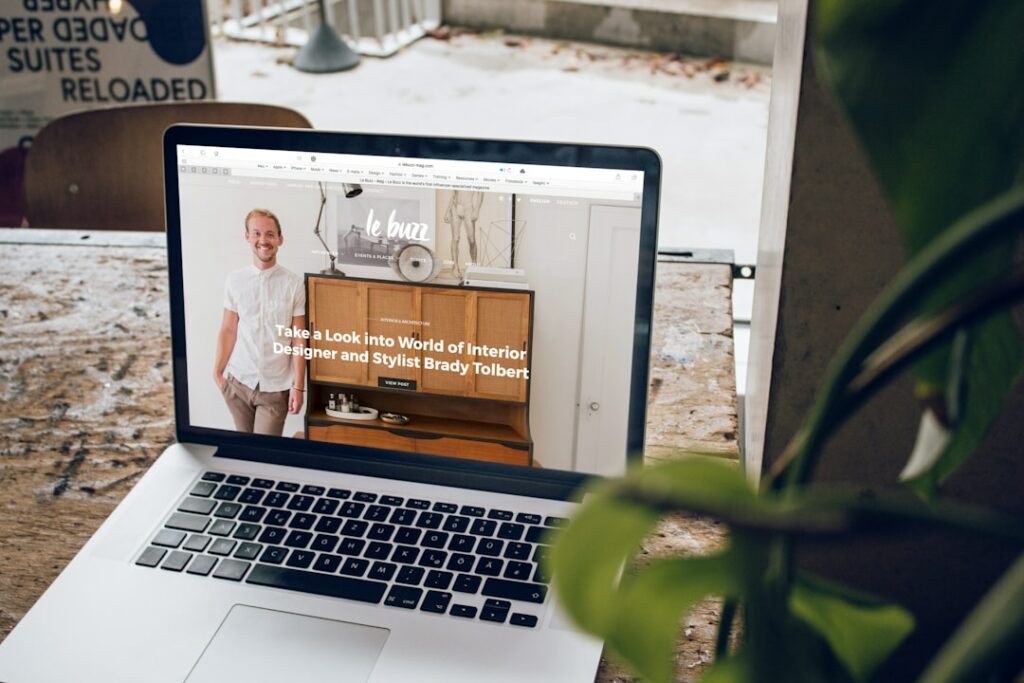UX-Design, or User Experience Design, is a crucial aspect of website and application development. It focuses on creating a seamless and enjoyable experience for users by considering their needs, preferences, and behaviors. In today’s digital age, where competition is fierce and attention spans are short, having a well-designed user experience can make all the difference in attracting and retaining users.
Keeping up with UX-Design trends is essential for staying ahead of the game. As technology evolves and user expectations change, it is important to adapt and incorporate new design techniques and strategies. By staying up to date with the latest trends, you can ensure that your website or application remains relevant and engaging for users.
Zusammenfassung
- Du solltest dich mit UX-Design Trends auseinandersetzen, um deine Website oder App auf dem neuesten Stand zu halten.
- UX-Design verbessert die User Experience, indem es auf die Bedürfnisse und Wünsche der Nutzer eingeht.
- UX-Design Trends können sich auf die SEO auswirken, da Suchmaschinen die Nutzererfahrung berücksichtigen.
- UX-Design Trends können auch die Konversionsrate beeinflussen, indem sie das Vertrauen und die Zufriedenheit der Nutzer steigern.
- Responsives Design ist wichtig für eine gute UX, da es die Benutzerfreundlichkeit auf verschiedenen Geräten gewährleistet.
How UX-Design improves User Experience
UX-Design plays a crucial role in enhancing user experience. It involves understanding the needs and goals of users and designing interfaces that are intuitive, efficient, and visually appealing. By focusing on the user’s journey and removing any obstacles or frustrations, UX-Design can greatly improve the overall experience.
For example, a well-designed e-commerce website will have clear navigation, easy-to-use search functionality, and a streamlined checkout process. This not only makes it easier for users to find and purchase products but also increases their satisfaction and likelihood of returning in the future.
Another example is mobile app design. With the increasing use of smartphones, it is essential to create mobile-friendly interfaces that are optimized for smaller screens. By using responsive design techniques and considering the unique needs of mobile users, UX-Design can greatly enhance the usability and enjoyment of mobile apps.
UX-Design Trends and their impact on SEO
UX-Design trends not only affect user experience but also have an impact on search engine optimization (SEO). Search engines like Google prioritize websites that provide a positive user experience, as they want to deliver the most relevant and useful results to their users.
One UX-Design trend that positively impacts SEO is the use of mobile-friendly design. With the rise of mobile search, Google has made mobile-friendliness a ranking factor. Websites that are not optimized for mobile devices may be penalized in search rankings. By implementing responsive design and ensuring that your website is mobile-friendly, you can improve your SEO performance and attract more organic traffic.
Another trend that affects SEO is page loading speed. Users expect websites to load quickly, and search engines take this into account when ranking websites. By optimizing your website’s performance and reducing page load times, you can improve both user experience and SEO.
The influence of UX-Design trends on Conversion Rates
Conversion rates are a key metric for measuring the success of a website or application. UX-Design trends can have a significant impact on conversion rates by influencing user behavior and encouraging desired actions.
One trend that positively impacts conversion rates is the use of clear and compelling call-to-action (CTA) buttons. By using contrasting colors, concise copy, and strategic placement, UX-Design can guide users towards taking the desired action, such as making a purchase or signing up for a newsletter.
Another trend that affects conversion rates is the use of social proof. By incorporating testimonials, reviews, and user-generated content, UX-Design can build trust and credibility, which can increase conversion rates.
The significance of Responsive Design for UX
Responsive design is an approach to web design that aims to provide an optimal viewing experience across different devices and screen sizes. It involves designing and developing websites that automatically adjust their layout and content based on the device being used.
Responsive design is essential for providing a seamless user experience across devices. With the increasing use of smartphones and tablets, it is important to ensure that your website looks and functions well on all screen sizes. By using responsive design techniques, you can create a consistent and user-friendly experience for all users, regardless of the device they are using.
Successful implementation of responsive design can be seen in websites that adapt their layout and content based on the screen size. For example, a responsive e-commerce website will display product images and descriptions in a grid layout on a desktop but will switch to a single column layout on a mobile device for easier scrolling and navigation.
The impact of Microinteractions on User Experience

Microinteractions are small, subtle design elements that provide feedback and enhance the user experience. They can be as simple as a button changing color when clicked or as complex as a progress bar indicating the completion of a task.
Microinteractions play a crucial role in guiding users and providing feedback, which can greatly enhance the overall user experience. By adding small animations, sounds, or visual cues, UX-Design can make interactions more engaging and intuitive.
Successful implementation of microinteractions can be seen in mobile apps that use subtle animations to indicate loading progress or provide feedback when a task is completed. These small design elements not only make the app more enjoyable to use but also provide valuable information to the user.
How to make your website accessible with UX-Design trends
Accessibility is an important aspect of UX-Design that ensures that websites and applications are usable by people with disabilities. UX-Design trends can play a significant role in making websites more accessible and inclusive.
One trend that positively impacts accessibility is the use of clear and descriptive alt text for images. Alt text is used to describe images to users who are visually impaired and rely on screen readers. By providing accurate and descriptive alt text, UX-Design can ensure that all users can understand and interact with the content.
Another trend that affects accessibility is the use of proper heading structure. Headings help users navigate through the content and understand its structure. By using headings correctly and in a logical order, UX-Design can make it easier for users with cognitive disabilities or screen readers to understand and navigate the content.
The importance of Storytelling in UX-Design
Storytelling is a powerful tool in UX-Design that can engage users and create a memorable experience. By using narrative elements, UX-Design can evoke emotions, build connections, and guide users through a journey.
Storytelling can be used in various ways in UX-Design. For example, a website for a travel agency can use storytelling to showcase different destinations and create a sense of adventure. By using compelling visuals, descriptive copy, and interactive elements, UX-Design can transport users to different places and inspire them to book a trip.
Another example is the use of storytelling in onboarding experiences. By guiding users through a step-by-step process and providing context and explanations along the way, UX-Design can make the onboarding experience more engaging and enjoyable.
How to enhance User Experience with Videos and Animations
Videos and animations are powerful tools in UX-Design that can enhance user experience by providing visual interest, conveying information, and creating a dynamic and interactive experience.
Videos can be used to showcase products or services, provide tutorials or demonstrations, or tell a story. By incorporating videos into the user experience, UX-Design can engage users and provide them with valuable information in an engaging and memorable way.
Animations can be used to add visual interest and guide users through the interface. By using subtle animations for transitions, hover effects, or loading indicators, UX-Design can make interactions more intuitive and enjoyable.
The trend towards Personalized and Individualized User Experiences
Personalization and individualization are growing trends in UX-Design that aim to create tailored experiences for each user based on their preferences, behavior, and context.
Personalization involves customizing the user experience based on known information about the user, such as their location, past behavior, or preferences. For example, an e-commerce website can show personalized product recommendations based on the user’s browsing and purchase history.
Individualization takes personalization a step further by allowing users to customize their own experience. For example, a news website can allow users to choose their preferred topics and sources, and then deliver personalized news articles based on their selections.
By implementing personalization and individualization techniques, UX-Design can create more relevant and engaging experiences for users, which can lead to increased satisfaction and loyalty.
In conclusion, keeping up with UX-Design trends is essential for creating a successful user experience. By understanding the impact of UX-Design on user experience, SEO, conversion rates, accessibility, and personalization, you can ensure that your website or application remains relevant and engaging for users.
By incorporating the latest design techniques and strategies, such as responsive design, microinteractions, storytelling, videos and animations, and personalized experiences, you can create a seamless and enjoyable user experience that will attract and retain users.
Remember that UX-Design is an ongoing process that requires continuous learning and adaptation. By staying up to date with the latest trends and best practices, you can stay ahead of the competition and provide the best possible user experience.
Hey du! Wenn du dich für UX-Design Trends interessierst, solltest du unbedingt diesen Artikel über die Auswirkungen von UX auf SEO und Konversionen lesen. Es ist wirklich spannend zu sehen, wie sich das Nutzererlebnis auf die Suchmaschinenoptimierung und letztendlich auf die Conversion-Rate auswirkt. Aber das ist noch nicht alles! Wenn du deine Website für Suchmaschinen optimieren möchtest, dann schau dir auch diesen Artikel über die On-Page-Optimierung an: On-Page-Optimierung: Optimierung deiner Website-Inhalte für Suchmaschinen. Und vergiss nicht, dass auch die semantische SEO-Optimierung eine wichtige Rolle spielt. Hier findest du weitere Informationen dazu: Semantische SEO-Optimierung: Deiner Inhalte für die semantische Suche. Für erfolgreiche Offpage-Optimierung gibt es außerdem fünf hilfreiche Tipps in diesem Artikel: 5 Tipps für erfolgreiche Offpage-Optimierung. Viel Spaß beim Lesen und Optimieren!
FAQs
Was ist UX-Design?
UX-Design steht für User Experience Design und beschäftigt sich mit der Gestaltung von Produkten und Dienstleistungen, die eine positive Nutzererfahrung bieten sollen. Dabei geht es um die Optimierung der Benutzerfreundlichkeit, der Funktionalität und des Designs.
Wie beeinflusst UX-Design SEO?
UX-Design hat einen großen Einfluss auf die Suchmaschinenoptimierung (SEO), da es dazu beiträgt, dass eine Website benutzerfreundlicher und damit auch für Suchmaschinen attraktiver wird. Eine gute UX-Design-Strategie kann dazu führen, dass Nutzer länger auf der Website bleiben, mehr Seiten besuchen und somit die Absprungrate reduzieren. Dies sind wichtige Faktoren, die von Suchmaschinen wie Google berücksichtigt werden.
Wie beeinflusst UX-Design Konversionen?
UX-Design kann auch einen großen Einfluss auf die Konversionsrate haben. Eine gut gestaltete Website, die eine positive Nutzererfahrung bietet, kann dazu führen, dass Nutzer eher bereit sind, eine Aktion auszuführen, wie beispielsweise einen Kauf zu tätigen oder sich für einen Newsletter anzumelden. Eine schlechte UX-Design-Strategie kann hingegen dazu führen, dass Nutzer frustriert sind und die Website verlassen, ohne eine Aktion auszuführen.
Welche UX-Design-Trends gibt es?
Es gibt viele UX-Design-Trends, die derzeit populär sind. Dazu gehören beispielsweise eine klare und einfache Navigation, eine schnelle Ladezeit, eine mobile Optimierung, eine personalisierte Nutzererfahrung und eine barrierefreie Gestaltung. Auch der Einsatz von Animationen und interaktiven Elementen wird immer beliebter. Wichtig ist jedoch, dass die Trends immer im Kontext der Zielgruppe und des Produkts betrachtet werden sollten.






